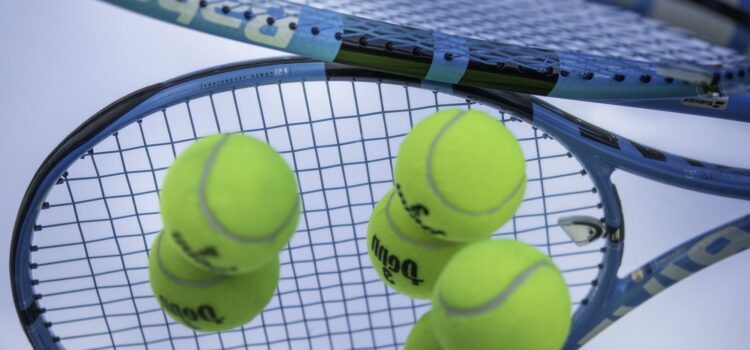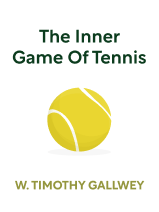

This article is an excerpt from the Shortform book guide to "The Inner Game of Tennis" by W. Timothy Gallwey. Shortform has the world's best summaries and analyses of books you should be reading.
Like this article? Sign up for a free trial here .
What is The Inner Game of Tennis by Timothy Gallwey about? What advice does he offer about how to improve your tennis game?
The Inner Game of Tennis by Timothy Gallwey focuses on combining your mental and physical game for the best results. By employing these “two selves” you can master your game and your mind.
Keep reading for top advice from The Inner Game of Tennis by Timothy Gallwey.
The Inner Game of Tennis: What It Means
In The Inner Game of Tennis, tennis pro and educator Timothy Gallwey explores the mind games that exist both in tennis and the rest of our lives.
He argues that we aren’t practicing and learning correctly and suggests a new method that is based on the concepts of playing an inner and an outer game, governed by two selves, one that relies on instinct and the other that governs the thinking mind.
The Mental Game of Tennis and the Inner and Outer Selves
To unlock your full potential as a tennis player, understand that tennis is a mind game. It is played more with yourself than with your opponent, and there are strategies to improve your relationship with yourself.
Gallwey calls the two selves “Self 1” and “Self 2.” Self 1 governs what he refers to as the “ego-mind,” and Self 2 governs the body and instinct. The “ego-mind” is what chastises you when you do poorly and compliments you when you do well.
Players are most successful when they can quiet Self 1 and let Self 2 take over, but this is rare.
While observing a tennis match, it’s obvious that most competitors are physically straining in unnecessary ways—their faces tighten or they curse at themselves. This is a manifestation of an inner self that is not well-calibrated and an ego that is working too hard for control, leading to physical reactions.
The goal is thus to play without thinking too actively or “over trying.” Good players of course still have to exert significant effort on the court, but there’s a difference between this and trying too hard, which almost always involves getting angry at yourself.
Players who have achieved mastery of the Inner Game are good at three skills:
- First, figuring out their own desired outcome
- Example: Wanting to hit a forehand deeper in the court
- Second, trusting Self 2 and not interfering too much
- Example: Not thinking too hard about the mechanics necessary to hit the forehand farther before swinging
- Third, thinking about themselves “nonjudgmentally”—noticing what is happening without passing a value judgment on their performance
- Example: Staying calm when you inevitably hit a few into the net
Each of these adds up to the idea of “relaxed concentration,” which is the Platonic ideal of a successful tennis player—fully in control and fully relaxed at the same time.
Mind Games
In The Inner Game of Tennis, Timothy Gallwey discusses the idea of “mind games.” Even once we have learned a better way of approaching learning and playing tennis, there are all kinds of mind games that we play with ourselves and our opponents that preclude us from being as successful as possible. It’s useful to learn what these games are so that we can understand better how to make changes to our game permanent and focus better on the court.
Tennis players will often do something called “grooving” strokes—they will hit a ball in a certain way so many times that a habit or “groove” is created. This can screw with a player’s head, because even if she is starting to focus more on Self 2, old grooves can be hard to break out of because they become physical.
Picture the Result
The solution to this is not to try to break out of old habits but to learn new ones. Swing without conscious control and then picture the result that you want. Hit with a picture of the result of the swing in mind and watch what happens. Don’t try to change the way you are hitting, try to change the outcome. Don’t try to hit your forehand with a tighter wrist, try to hit it deeper into the court. This can help create a new groove.
Use Imagery
In The Inner Game of Tennis, Timothy Gallwey recommends using imagery. We need to use imagery to communicate with our bodies. Here are three strategies:
- Ask for results: Imagine the result that you want—in tennis, hitting a forehand deep into the court with power.
- Ask for form: Imagine a change in the way that your body should move—for example, if you know you’re rolling over too much on the ball, think about exactly how you want your stroke to look. Consider shutting your eyes as you practice this.
- Ask for qualities: Pretend to be someone other than yourself—in the case of tennis, be a professional, and try to play like her. Or, adopt a style of playing tennis entirely different from the one you’re used to: If you’re a defensive player waiting to make a mistake, try to hit lots of winners. If you’re a more formal player, adopt a scrappier style. This will help you realize that you can rely on all of these qualities as a player.
Focus occurs not when you’re trying too hard to focus on something, but when you’re legitimately interested in something.
- Focus on the seams of the ball as it travels. Focusing on this one specific motion will both actually help the player see the ball better and will quiet the mind from thinking about anything else. Become absorbed in the pattern and the body will do everything else naturally.
- While you’re watching the ball, you also need to know where your racket is at all times. This introduces the concept of feeling, one of the most important in tennis. Spend a lot of time in practice feeling the exact path of your swing. This may produce undesirable immediate results, but taking the time to understand exactly how the motion of your swing affects the trajectory of the ball is essential. Remember nonjudgmental observation!
- Another tactic is listening to the ball. When the ball is closer to the sweet spot, it will make a better sound. Remember that sound and remember when you are able to reproduce it and the body will work towards making this happen more.
Focus on Here and Now
A lot of this success comes from a player’s ability to focus. We should be focusing our awareness on the here and the now.
- The here is the ball, the wind, our muscles, our stroke.
- The now is the point being played right in front of you.
Lots of players fall into the trap of thinking about past points they lost or future points they hope to win, which can spiral into thinking about winning or losing the match. Soon, they won’t be playing the game in front of them at all, just a game with themselves.
Know What Game You’re Playing
All this focus and ability to quiet the mind, though, will be not that useful if you don’t understand what game you are playing. People play tennis for lots of different reasons—Gallwey divides them into different “games”:
- “Good-o,” which includes attempting to reach perfection on the court for yourself, attempting only to beat your opponent, or attempting to look perfect as you play.
- “Friends-o,” which includes playing tennis either to increase your social status with a group of people or maintain it.
- “Health-o-Fun-o,” which includes playing either at a doctor’s orders or because of a personal health kick, or playing only for the enjoyment of the game (the latter of which is ultimately quite rare).
Most people play a combination of these games with themselves, and each game has its own set of obstacles, like wanting badly to beat your opponent or feeling the need to lose weight. We should figure out what game we are playing with ourselves so we can better understand the obstacles in front of us and how to overcome them.
Competition and Cooperation on and Off the Court
One of the most essential lessons for improving your mental health through tennis is to attempt to remove your play from your self-worth. This can significantly help your life off the court as well. The Inner Game of Tennis by Timothy Gallwey offers advice for this as well.
The key is to stop using competition to derive your own self-worth but also to continue to get a lot out of playing. This is only doable if you can find other obstacles and challenges to overcome that will make you feel good about yourself.
Winning is only valuable if the goal itself is of value to the individual. Find a personal victory and attempt to accomplish it. In this way, competition and cooperation can be indistinguishable: Each player can become an obstacle to the other one in reaching an ultimate goal. One player can be pushing the other to improve strokes while the other can serve as an opponent that’s particularly difficult to defeat. These obstacles stop being negatives that drain on your self-worth and become positive challenges to overcome. If the obstacles are easy, the ultimate goal won’t be of as much value.

———End of Preview———
Like what you just read? Read the rest of the world's best book summary and analysis of W. Timothy Gallwey's "The Inner Game of Tennis" at Shortform .
Here's what you'll find in our full The Inner Game of Tennis summary :
- Why tennis is actually a mind game
- How to quiet the mind and concentrate intently
- Why your self-worth shouldn't be dependent on how you do in competition






